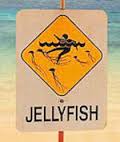Overview
Jellyfish are found in all the world’s oceans, from the surface to the deep sea. Most live in saltwater, although there are a few species that live in fresh water. Jellyfish have soft bodies and swim freely for much of their adult lives.
Kinds of Jellyfish
There are hundreds of different species of jellyfish. Adult jellyfish (sometimes called jellies) have an umbrella-shaped bell, with tentacles that hang from the bell. Different species of jellyfish live in every ocean, and some species live in fresh water. Some live near the surface, while others live in the deep sea. They have soft bodies, unlike the vertebrate skeletons of fish. They move through the water efficiently by rapidly expanding and contracting their bell-shaped bodies to push water behind them.
Ecology of Jellyfish
Most species of jellyfish eat plankton, small crustaceans, fish eggs, small fish, and other smaller jellyfish. Their prey are caught in the vortex created by their movement through the water, then entangled in tentacles. They are preyed upon by larger jellyfish, tuna, shark, swordfish, and sea turtles. Jellyfish tend to gather in large swarms, often called “blooms”, and some invasive species of jellyfish grow in new habitats, overwhelming other populations of marine creatures. They are relatively more adapted to survive in warmer waters that contain less oxygen but more nutrients, such as agricultural runoff.
Toxic Jellyfish
Many species are poisonous, with toxic stingers on the tentacles. Most stings are not deadly, but a few species are highly venomous, and their stings can be fatal. The sea wasp and other forms of box jellyfish hunt their prey rather than drifting toward it. Beaches in Australia have warning signs against stinging jellyfish. The most effective protection against jellyfish stings is wearing protective covering, such as a wetsuit or even pantyhose, as the stinging cells cannot touch the skin and react with it chemically.
Life Cycle of Jellyfish
Eggs develop into free-swimming larvae. The free-swimming larvae settle onto firm surfaces and become polyps, similar to sea anemones. The polyp then breaks off to become an adult medusa, or jellyfish. Life spans vary depending upon the size and species. The smallest species may live only a few hours, but many large coastal species live for months. Aquarium jellyfish can live several years, as they have regular food and are tended carefully.
Interested in science tutoring services? Learn more about how we are assisting thousands of students each academic year.
SchoolTutoring Academy is the premier educational services company for K-12 and college students. We offer tutoring programs for students in K-12, AP classes, and college. To learn more about how we help parents and students in Campbellton, NB, Canada: visit: Tutoring in Campbellton, NB, Canada



